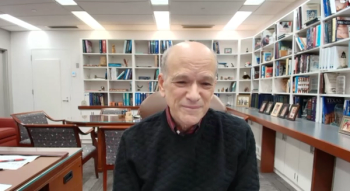
Targeting the Glutamatergic System for Treatment Resistant Depression
Two experts examine the impact of targeting the glutamatergic system as therapy for treatment resistant depression.
Episodes in this series

Lisa Harding, MD: I’ll ask a question that you touched on a little earlier to get into the drugs that target the glutamatergic system. What do you think about them in fitting into this algorithm of treatment-resistant depression [TRD]?
Angelos Halaris, MD, PhD, APA, ACNP, CINP: In my practice, after I’ve determined that we’re dealing with a true TRD, not a presumptive TRD—I know I sound like a broken record—
Lisa Harding, MD: I’m with you on that broken record. I’m the other half of it.
Angelos Halaris, MD, PhD, APA, ACNP, CINP: I consider 2 options in my algorithm of choices: either TMS [transcranial magnetic stimulation], which is also very time consuming, given that the average number of sessions is about 35. It’s a minimum 3 days a week on site in the office, preferably 5 days a week. That amounts to roughly 7 or 8 weeks back to back. It also requires maintenance. The response is generally quite good. Even after the first few treatments, we can get a response, but I’ve also witnessed the loss of efficacy after termination of the initial acute treatment phase of about 35 sessions.
Lisa Harding, MD: I agree with you. I do this clinically as well, and it’s a travesty that we can’t figure out what maintenance looks like. It’s really good to hear a colleague express this as well, and that I’m not on an island by myself with these same outcomes.
Angelos Halaris, MD, PhD, APA, ACNP, CINP: Next to TMS, I consider intranasal esketamine. I’ve used it before approval by the FDA in 2019 in phase 3 clinical trials and subsequently after it was approved at our institution. I still do it. As a matter of fact, I had a maintenance patient just an hour ago, and another is coming back for maintenance intranasal esketamine right after we’re done with this discussion. It’s a very interesting approach, not so much the classic neurotransmitters or serotonin-norepinephrine-dopamine, but at the NMDA receptor blockade that involves predominantly, but not exclusively, glutamatergic transmission.
Lisa Harding, MD: Absolutely. What are your thoughts on the intravenous ketamine that is used off-label? We’ve been using that off-label since before intranasal esketamine came on the market.
Angelos Halaris, MD, PhD, APA, ACNP, CINP: Yes. I haven’t used the intravenous ketamine for the reasons you mentioned. It’s not FDA approved. It’s very costly. It is not really regulated, as intranasal esketamine is by the REMS [Risk Evaluation and Mitigation Strategy] program.
This transcript has been edited for clarity.
Newsletter
Receive trusted psychiatric news, expert analysis, and clinical insights — subscribe today to support your practice and your patients.


















